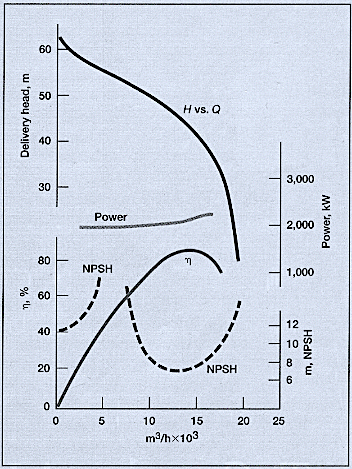Perhaps the simplest definition of a tutor is a person, device, or other item that provides well-focused instruction. That type of instruction usually results in avoidance of costly mistakes, repeat failures, delays, anxieties, even loss of one’s job.
BOOKS AS TUTORS
Four 40-ft.-long vertical pumps, similar to the one in the system shown in our opening image (above), and designed per the performance plot in Fig. 1 (below) were used in seawater-intake service in the 1990s (Ref. 1). The pumps experienced frequent failure of column bearings because “forces higher up” in the organization had insisted on always operating three, and sometimes even all four units in parallel. More often than not, the facility’s total demand was such that on a per-pump basis, each of the pumps on line was running in the low-flow, considered inoperable, extremely high NPSHR region, far to the left of the Best Efficiency Point (“BEP”). Violent shaft vibration had then resulted in frequent and serious damage to the lower column bearings.

Fig. 1. Pump-performance curve showing forbidden operating range,
due to abnormally high (generally unavailable) NPSH requirement.
Depending on prevailing H/Q relationships, operation at the resulting low (or even zero) flow would cause one or more pumps to fail. Although this is a well-known issue, it tends to be overlooked. Books (our tutors) explained why we should have examined the head/flow (H/Q) curves of such cooling-water pumps and found the courage to explain to “forces higher up” if a counter-productive attempt was made to operate too many of these pumps simultaneously. Of course, the pitfalls and risks of operating certain pumps in parallel are different for those with the “open” NPSH curve shown in Fig. 1, as opposed to pumps with risks incurred because their performance curves are too flat for parallel operation.
Then there is another interesting issue that merits sharing. About 30 years ago, I was asked to visit a nuclear facility that experienced frequent bearing failures on emergency generating equipment. The most probable cause was a fan-like blower wheel, which an eager employee had fitted to the shaft at a location close to the bearing housing. While the fan may have promoted increased air flow to the bearing housing, it very probably caused a pressure difference between the inboard and outboard sides of the bearing. Indications of oil starvation were found on one side of the bearing. No such starvation problems were reported on equipment that did not come equipped with the “novel” fan-like blower add-on.
Still, related to that long-ago emergency-generator bearing issue, even today, some three decades later, plant personnel would certainly want to know the viscosity grade of the lubricant used in a generator’s bearings. Read on for the reason why.
Misguided attempts to “standardize” on certain lubricants have often proved costly, but people without tutors tend to be slow learners. Whenever oil needs to be lifted into the bearings with slinger rings, oils that are too high in viscosity will cause those rings to malfunction. Slinger rings that are out-of-round will also malfunction, as will slinger rings that are too deeply immersed in an oil sump. And just think what happens when some of these deviations occur simultaneously, or when violent shaking causes slinger rings to dislodge, or cold ambient temperatures turn oil into a more viscous mass.
So, my message here is to examine issues common to certain “standardization” practices. Focus on elusive problems that are rooted in single deviation events. When such events combine with others, serious problems are much more likely to show up in a plant. Thus, it’s a good idea to consider making books your “tutors.”
MANUFACTURERS AS TUTORS
Experienced manufacturers can also serve as your tutors. They should come from the best-qualified vendors, and purchasers should put into their budgets the cost of best-technology equipment these vendor/tutors can provide.
The relevance of this plea was re-emphasized when a purchaser came close to buying high-pressure-ratio air compressors with standard plastic internal parts. Working with a more highly experienced manufacturer, perhaps one that made the widest possible range of single-stage air compressors, might have allowed the purchaser to understand what is, and is not, technologically feasible. A knowledgeable tutor would surely have pointed out the pitfalls of certain low-cost components.TRR
REFERENCE
1. Bloch, H.P., “Petrochemical Machinery Insights,” (2017) Elsevier Publishing, Oxford, UK, and Cambridge, Massachusetts, ISBN 978-0-12-809272-9.
Editor’s Note: Click Here To Download A Complete List Of Heinz Bloch’s 22 Books
ABOUT THE AUTHOR
Heinz Bloch’s long professional career included assignments as Exxon Chemical’s Regional Machinery Specialist for the United States. A recognized subject-matter-expert on plant equipment and failure avoidance, he is the author of numerous books and articles, and continues to present at technical conferences around the world. Bloch holds B.S. and M.S. degrees in Mechanical Engineering and is an ASME Life Fellow. These days, he’s based near Houston, TX. Email him at heinzpbloch@gmail.com.
Tags: reliability, availability, maintenance, RAM, asset management, professional development, pumps, generators, bearings, lubrication



